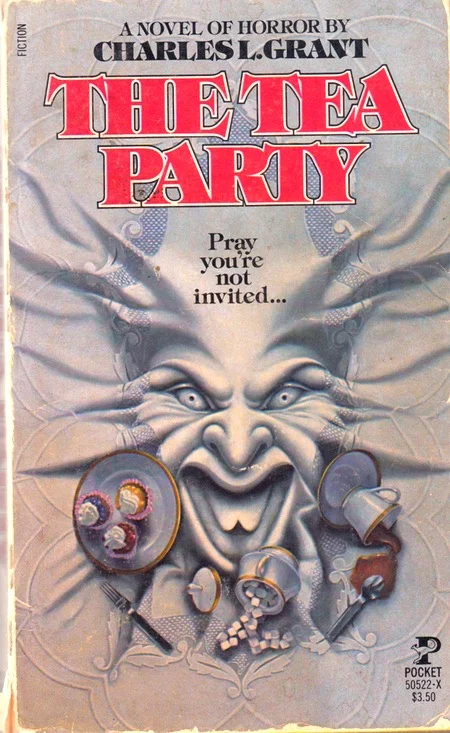The Tea Party? Do you mean the right-wing political movement that dominated President Obama's first term? Or do you mean the Canadian prog rock band? Or are we talking about the event that sparked the American Revolution?
None of the above! We're talking about Charles L. Grant's 1985 horror paperback with one of the best covers ever (by the always-amazing Lisa Falkenstern).
Author of around 70 novels, editor of innumerable anthologies, Grant wrote under his own name, as well as those of Felicia Andrews, Deborah Lewis, Simon Lake, Geoffrey Marsh, and Lionel Fenn. A consummate stylish, Grant was a Vietnam vet who didn’t like Lovecraft and who hated gore, preferring instead to traffic in what he first called “dark fantasy” and what was later called “quiet horror.” He believed deeply that the old tropes could have new life, it all just depended on the quality of the writing. He believed this so deeply that he even published three novels set in the 19th century and based on the Universal studios Dracula, Wolfman, and the Mummy. Of course he also published X-Files and Millennium tie-in novels, as well as the novelization of Hudson Hawk, so it’s not like he was some precious aesthete in a velvet smoking jacket hiding from the 20th century in a crumbing Victorian pile.
Grant was a purveyor of whispers and darkness, full moons and empty nighttime streets, small New England towns full of shadows and, especially, fog. He loved fog passionately, helplessly, and hopelessly, as in the opening to The Tea Party:
“The fog had been there from the beginning. When the Appalachians rose in dark volcanic flame and the sea slid back boiling, when the centuries-old glaciers gouged and ground and crushed their way through to pulverize the land and create the narrow valleys, when the lakes filled with rain and the beasts returned to prowl the forests, the fog was there, barely shifting, seldom rising; when the trees finally grew and the land became fertile, when the birds returned to roost and Man was born, the fog was there, breathe of the night and mirror of the moon, scuttling to shadow ahead of the sun, returning at dusk to claim its place.”
Shades of the opening of Bleak House. That fog is being foggy in Deerford Village, CT, one of Grant’s small, fictional, picture postcard New England towns like Maple Landing, Oceanside, Greystone Bay, and his favorite, Oxrun Station. Deerford is dominated by Winterrest, a stone manor house on the outskirts of town, built in the 18th century by a stone mason so skillful that you can’t even see the joints between the blocks. Unfortunately, dude was less skilled at picking non-cursed land to build his house on and a few years later his entire family disappears.
Cut to modern times and a small town soap opera, already in progress. Doug Muir, architect, is hiding out and trying to get over having accidentally killed his wife’s lover. Fighting over him like two dogs with a bone are the lady lawyer, Liz, and Judy, owner of The Depot, the town's local watering hole. Both live in tremulous hope that one day Doug will ask them to get married, and both are additionally burdened, by Casey in Judy’s case, a drunk brother who claims demons live at Winterrest, and by Kevin in Liz’s case, her son who sneaks into Winterrest on a dare and comes out acting funny.
Seemingly immortal local real estate agent, Eban Parrish, keeps making noises about a developer coming to town to buy up everyone’s property which makes everyone go all NIMBY but then they chill when Parrish stages the titular tea party on the Winterrest grounds. But it's not going to be a scene of homeowners munching scones, so much as Winterrest munching on them. That’s where we get the fun stuff. Winterrest is made of living stone and it's pissed, so we get scenes of boulders chasing drunks across the lawn and bouncing up and down on their heads, sentient gravel drilling into human flesh and skinning all the meat from a guy’s lower body until he’s running away on skeleton legs, and a woman beaten to death by sentient stone flowers.
But a lot of the book is devoted to hazy backstory and elusive clues. People are possessed and wander off in a daze, just sort of going along with things. As well-written as the book is, and as fun as the rock attacks are, it all just sort of...drifts. Like his precious fog, Grant liked to blur lines rather than shatter boundaries, and here the fog blurs the hard edges and muffles everything, swaddling the proceedings in cotton. Grant loved the trappings of classic horror fiction — empty mansions, spooky forests, towns whose placid surfaces hide ancient evil — but ultimately the setpieces build to a late night horror show ending, with a mansion in flames and the survivors running for their lives. If there’s something deeper here, then it lurks out of sight, as misty and insubstantial as Grant’s beloved fog.
